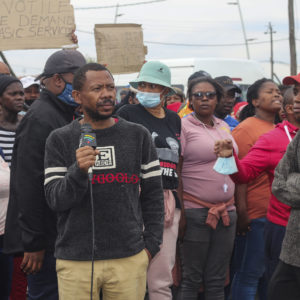Pietermaritzburg was a dump long before the riots
The effects of the past week’s unrest and destruction of property will have dire consequences for the KwaZulu-Natal capital, whose residents have watched for years how their city has been ruined.
Author:
16 July 2021

Rubbish sits in piles on Masukwana Street in central Pietermaritzburg, KwaZulu-Natal, as a group of concerned residents rummage around to find more plastic bags in which to put the waste they have gathered. Theirs is a clean-up operation to clear the detritus left by the food riots that morphed from a campaign to free incarcerated former president Jacob Zuma into the wholesale destruction of several key establishments by criminals.
The municipality has announced that “refuse collections, street sweeping, grass-cutting services and the operation of the landfill site are currently suspended” owing to the riots. But according to residents, Pietermaritzburg’s city centre resembled a dump site prior to the riots, the aftermath of which has been compared to war-like scenes.
Residents say large piles of rubbish have sat next to bins that have been overflowing and not cleared in years. The walls stink of urine and some buildings leak water out to the busy streets. A walkabout in Pietermaritzburg wouldn’t be complete without running into a rat. If one is lucky enough to be driving, the gaping potholes make a mockery of the city being the capital of the province.
Related article:
“The only reason I live in the city is because it is close to work, but the city was in a bad state even before the riots,” says Sibusiso Mkhize, who lives in a flat in the city centre. “When I was a child, I used to get dressed up, excited to go to town because it was a beautiful place where you got fresh air and it was precious. Now I can’t wait for weekends or my leave so I can go home.”
Poor financial management, weak internal controls, failure to comply with key legislation and a lack of accountability have resulted in a long battle for the Msunduzi local municipality to stay efficient and afloat.
The clean-up crew say they took the initiative because the community cannot depend on the government to get things done. “Some of these things we can do ourselves. There is a lot of damage here and I am so proud to see people come out in numbers. I have never seen such unity before in the city. I think we will be faster than the municipality could be, if we keep up today’s momentum,” says Mkhize.
Uncaring municipality
In June, there was a minor victory for the community of Sobantu and surrounding areas when the high court found the Msunduzi municipality in violation of several environmental laws over its mismanagement of the toxic New England Road municipal landfill. Residents had been trying for a decade to get the municipality to take responsibility for running the site properly.
Five waste pickers had died there and more had been injured, and it was a clear hazard to Sobantu residents, who live next to the landfill. Yet the South African Human Rights Commission had to step in to protect their rights. This is only one of the ways in which the municipality has been found wanting. It has been placed under administration twice and stands accused of maladministration and gross mismanagement of funds.
With losses from the destructive riots running into billions, 45 000 businesses affected and more than 129 000 jobs lost in Durban alone, economists estimate it could take up to 20 years for South Africa to recover – but only if the government is efficient and honest and puts people’s interests first. It will be much longer if the history of poor governance continues.
Related article:
In Pietermaritzburg, a simple process such as getting water and electricity bills can be chaotic. The residents complain that the bills they receive from the municipality are almost always incorrect, which means they have to travel to the municipal office to set them right.
“There was no plan to manage the waste and there were always water shortages along with the electricity challenges,” Mkhize says.
The KwaZulu-Natal Economic Council warned on Tuesday 13 July that the “violent protests would have a negative impact on the provincial government’s plans to grow the economy and create jobs”.
Silver lining
Pietermaritzburg mayor Mzimkhulu Thebolla acknowledged past “challenges” on Thursday 15 July, but said the riots had brought an unexpected show of unity as 3 000 volunteers from businesses and non-governmental organisations cleaned up the city.
“The response was amazing,” said Thebolla. “We had made the call for people to partly be responsible for the state of the city, but the call never got such a positive response. Someone was actually saying the city looks cleaner than it has been in years.”
Political killings, drug turf wars and taxi violence have ripped through Pietermaritzburg and turned the city into the country’s murder capital. Plessislaer police station had the highest murder rate in South Africa, according to the latest crime statistics that were released in May. Some incidents have sent shockwaves throughout the nation, such as the killing of seven suspected gang members in a shootout with the police in Scottsville. They had been linked to crimes across the city.
Given Pietermaritzburg’s propensity for violence, one can only imagine the effects the riots and their aftermath will have on residents. “Part of the reason we wanted people to come out in numbers is the fact that we want to claim back our city from looters, gangsters and quell the racial tensions that were beginning to rise,” Thebolla said.
The people of Pietermaritzburg have seen a slow but steady decline in their city over the years. It has been exacerbated by the riots and the total destruction of their economic hubs. But among the devastation is a clean slate on which to set new intentions and thrive.


